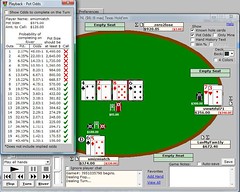http://www.pokerhand.org/?1625641
FullTiltPoker $3/$6 - 4 handed
Dealt to smizmiatch [6c 5d]
CO folds
smizmiatch raises to $21 from Button
SB folds
Villain calls $15 from BB <-- He's very loose from the blinds.
*** FLOP *** [4c 2d 8d] <-- I flop great with a double belly buster
Villain bets $25
smizmiatch calls $25 <-- I call rather than raise because my hand is well-disguised and I figure my opponent caught a piece of the flop
*** TURN *** [4c 2d 8d] [6s]
Villain bets $60 <-- I don't know what to put him on. Some kind of draw? Some weird BB two pair hand? Why would he bet it out on two streets?
smizmiatch raises to $180 <-- I'm going to try to put an end to this right now with about 5 trillion outs
Villain raises to $300 <-- Wtf is up with the minraise?
smizmiatch has requested TIME
Here is where I go into the tank. I think about going all in, but the villain has shown nothing but strength. I'd hate to call drawing dead to a 7. But really, I think I'm up against some random two pair at this point, in which case I also don't want to go all in.
If I'm not going to push, I guess I have to do the math. I fumbled around on my keyboard for a second before finding the Windows calculator.
My pot odds were better than I thought they'd be at 21 percent (120/575)! With as many as 13 outs, I'm calling here for sure.
 Click for enlarged view
Click for enlarged viewsmizmiatch calls $120
*** RIVER *** [4c 2d 8d 6s] [8h] <-- Actually, a great card because it would counterfeit a hand like 64 or 55. But my read is fuzzy.
Villain bets $256, and is all in <-- Is he doing this just because I took so much time on the turn?
smizmiatch has requested TIME
smizmiatch calls $254, and is all in <-- The pot is offering 3:1 odds. I think I'm good more than a quarter of the time. For some reason, my spider sense is telling me he doesn't have an 8.
Uncalled bet of $2 returned to Villain
*** SHOW DOWN ***
Villain shows [7h 3h] a pair of Eights <-- Missed his gutshot draw
smizmiatch shows [6c 5d] two pair, Eights and Sixes
smizmiatch wins the pot ($1,201) with two pair, Eights and Sixes <-- El doble!
Villain is sitting out
I don't know how to feel about this hand. I sensed weakness somewhere, but my read was wrong.
It must have been the minraise on the turn that seemed weak, even though it was meant to look strong.


